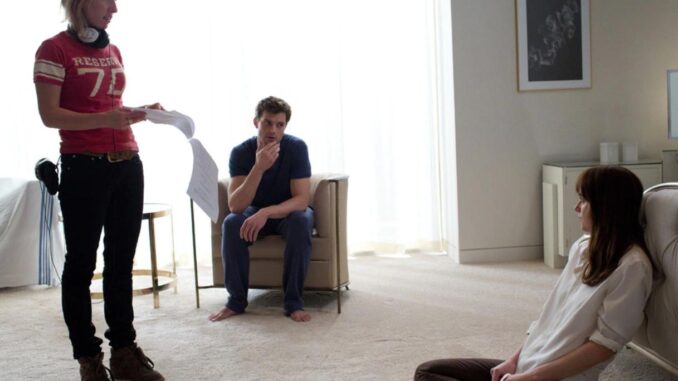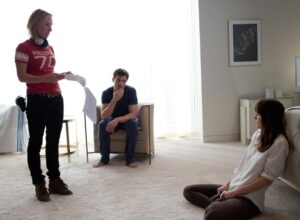
The third movie in the Fifty Shades saga—really, this is a saga—comes out February 9, just in time for ironic Valentine’s Day plans. Thus, I—an entertainment writer and self-respecting lover of terrible movies—have decided it’s high time to finally watch them, taking on Fifty Shades of Grey and Fifty Shades Darker in the weeks before the finale comes to theaters so that I’ll be ready when things finally… climax.

Well, I’ve done it. Over the course of three weeks, a trial as emotionally and physically arduous as anything the young Anastasia Steele faced in the loathe-yet-magnetic red room, I have watched all three movies in the Fifty Shades trilogy. I now know Dakota Johnson’s naked breasts and Jamie Dornan’s blank, empty face as well as I know my own two hands, and I’ve fully grasped what I can only assume to be the thesis of this franchise: Rich people don’t have real problems, and capitalism is a broken system which will continue to exploit the working class and reward the unremarkable until we see full-scale economic revolution. The real domination is not Christian Grey’s feeble use of a riding crop, but rather the way he has consigned his employees to a life of meager deference, kowtowing to his 22-year-old bride who gleefully watches all of her dreams spread out before her like ripe fruit on a platter, waiting for her to thoughtlessly pluck up into her manicured fingers and pop into her mouth.
Fifty Shades Freed finds Anastasia and Christian getting married and going on a whirlwind European honeymoon that we, as the audience, infuriatingly only see in montage-snippets. (What is the point of this wealth-porn if we cannot vicariously plan a lavish wedding celebration? A wall of flowers isn’t going to cut it; we’ve already seen that on Kim K’s Instagram.) Ana returns home to find that in her absence, she, a 22-year-old who had just months ago graduated college and began work as an assistant, is now the senior acquisitions editor at a major publishing company. How lucky! She and her handsome new husband kiss and have sex and buy a house and escape the sinister Jack Hyde, Ana’s former boss who’s become obsessed with destroying their lives.

In a haphazard third act, Hyde kidnaps Christian’s sister and forces Ana to bring ransom. Ana briefly becomes Jason Bourne, and Hyde is defeated. Also, Ana is pregnant, and though Christian had previously thrown a fit about it, now he’s decided he’s happy about it.
This movie is only about an hour and a half, but it feels as though it lasted for 5,000 years. Whether to blame the source material, the directing, the editing, or the actors (Johnson is a delight, Dornan is a corpse warmed up) is an unnecessary conversation. With Fifty Shades Freed, we are the ones who have all been freed. (Dakota Johnson presumably popped the champagne.)
But of course, there are still lingering questions, questions like:
How does Ana not know that Christian owns a plane?
After Ana and Christian drive away from their wedding, their chauffeured car brings them to a runway with a private jet. “You own this?” Ana asks, incredulous. “We own this,” Christian magnanimously corrects her. But… how does that surprise Ana at all? In the last movie, Christian mentioned buying an airline. An AIRLINE! More than a single plane! He has brought her on planes before, not to mention a personal helicopter emblazoned with the Grey logo. How does she need clarification about whether or not he might be wealthy enough to own a plane after being with him this long?
They kept Danny Elfman around, huh?
He has done the music for all three of these movies! Good on you, Danny Elfman!

How does Christian think a charm bracelet is a good gift?
Christian is set up as a paradigm of wealth and sophistication, and yet on their honeymoon, he gifts his new bride a charm bracelet. And a charm bracelet with an Eiffel Tower charm, which is the most infuriatingly and hilariously basic gift in the world. A charm bracelet is what a stepdad gives to his wife’s 13-year-old daughter who he doesn’t know all that well. It is clear from the fact that she never wears this bracelet again for the rest of the movie that Ana understands this.
How does Jack Hyde have the sophisticated hacking know-how to break into a tech company?
Jack Hyde was a fiction editor at an independent press in Seattle. There are a lot of skills that go along with being a fiction editor—speed-reading, attention to detail, contract negotiating, market awareness, conversational ability—but nothing in that role would give him the ability to hack into a company Ocean’s Eleven-style to retrieve top-secret data. Grey Industries is a technology company. And presumably, they have a basic security setup. Yet somehow, a middle-aged literary professional is able to hack—literally hack, using all of a movie’s “hacking” visuals—into its mainframe or data center or whatever. See? I’m a writer; I don’t know these things.
